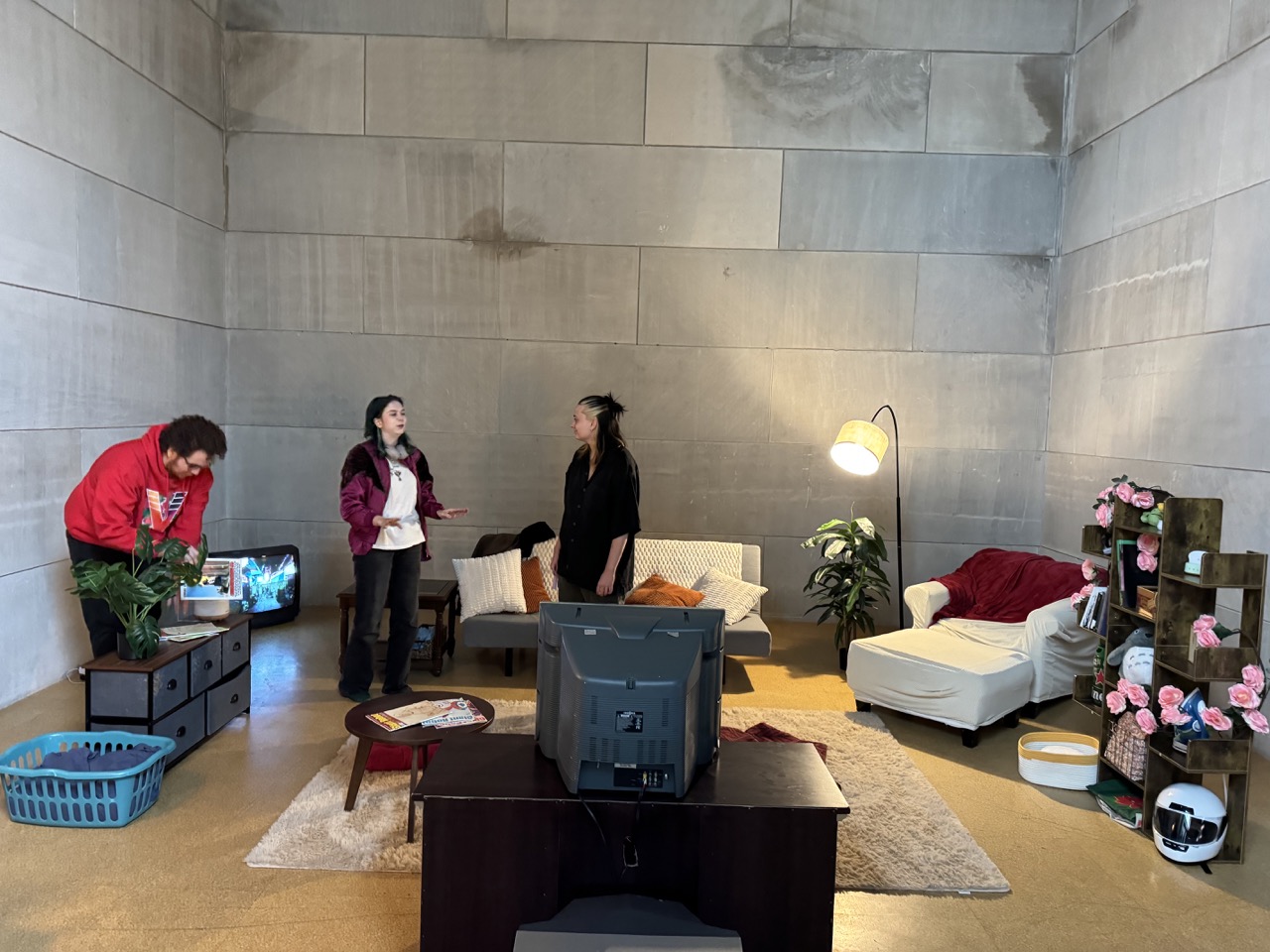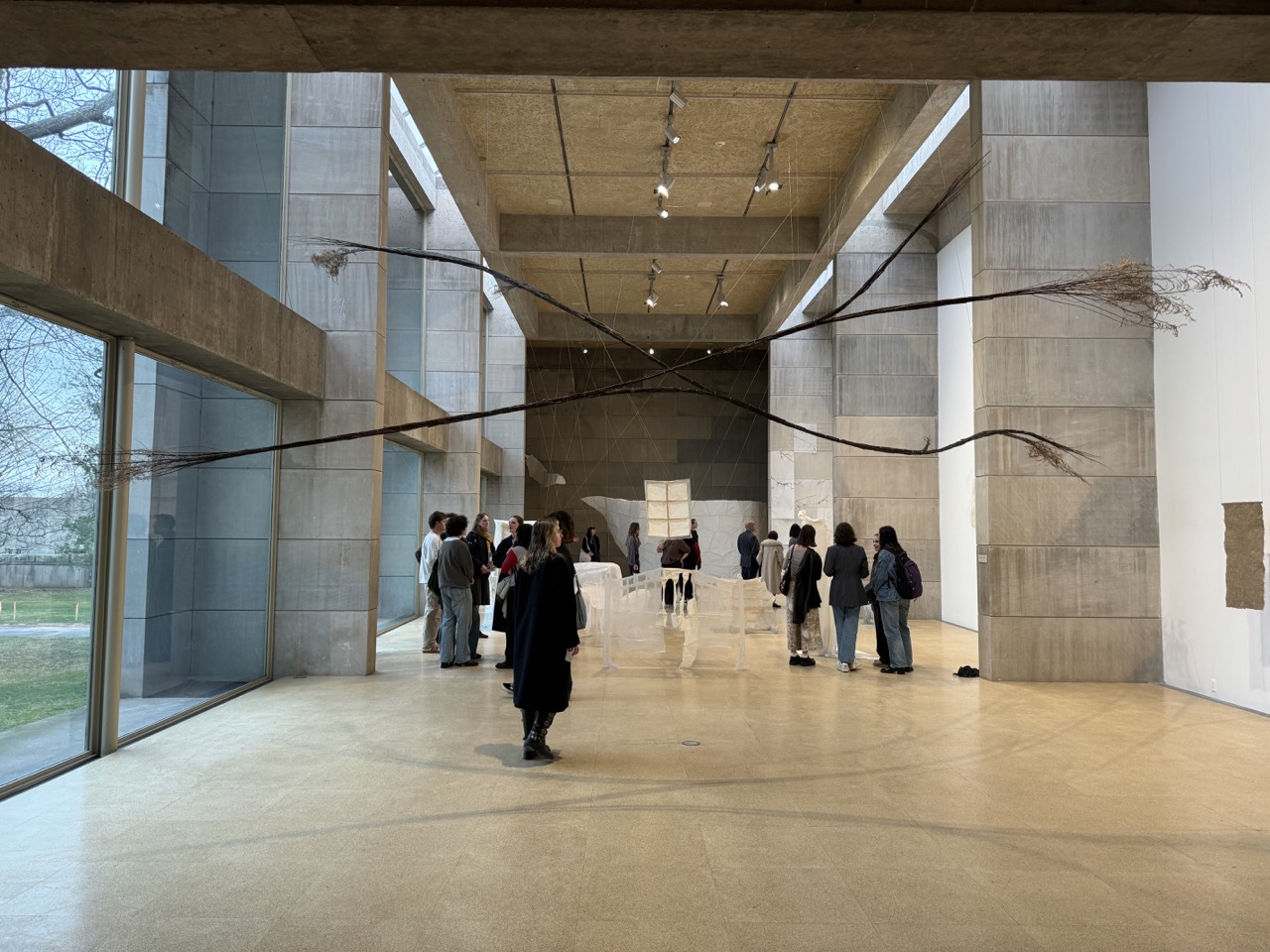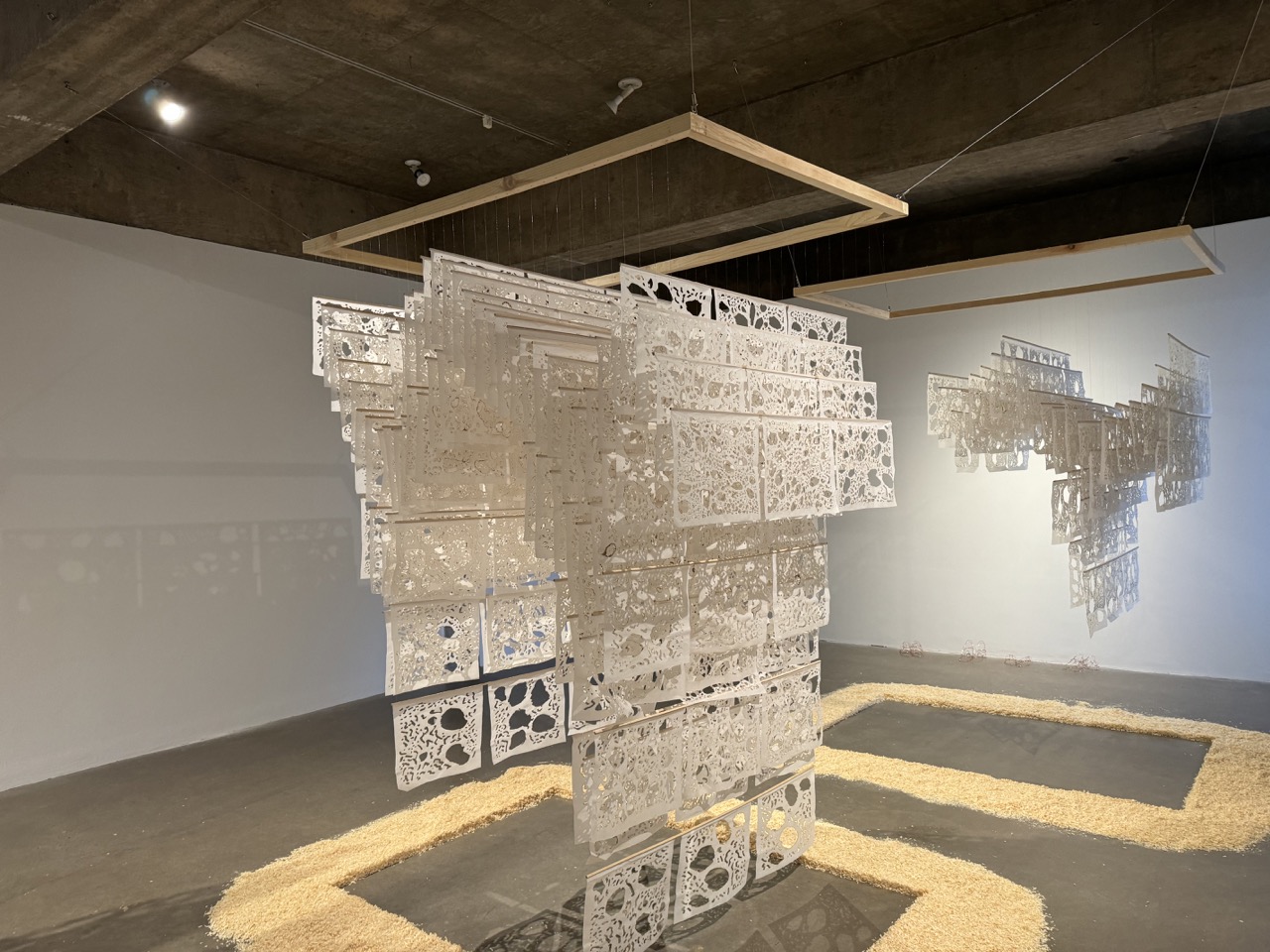
c/o Nicole Lee
The Ezra and Cecile Zilkha Gallery premiered the studio art theses of six seniors on Wednesday, March 27, all of them grand, floor-to-ceiling pieces. Viewers were encouraged to move through the work, examine it from all angles, and step gingerly. The six pieces, while distinct, seemed to invite comparison—not for the viewer to let them blur together, but to consider how the art forms present in one subtly showed up in the others.
On the day of the reception, Zilkha Gallery was packed; friends and family of the artists moved feverishly among the exhibitions. At any given time, the artists were surrounded by sizable crowds hanging on their every word about their pieces and processes. I had the pleasure of speaking with many of them that day about their work.
“This structure is about immigration,” Rebeca Treviño ’24 said, from where her thesis was installed in the Zilkha Uncommons. “I worked from personal stories that you can hear in the audio, which is really faint, as well as my own story.”
The faint audio she referred to was a collection of interviews conducted with immigrants about their experience, which went on to inform her piece, “States of Belonging.” The work was a hanging garden of meticulously burned paper, which formed a pathway over squares of sawdust that began sharply formed but was meant to be walked through and messed up.
“As people move through it, it changes,” Treviño said. “When you first encounter the structure, if you look at it from afar, it creates a sort of wave, which speaks about borders and the types of borders our societies have, which are created by natural landmarks…. But if you look at it like this, it’s almost…a wall, which talks about the other types of borders that we have, which are man-made borders.”
As Treviño spoke, it became clear that for her, the paper itself was one of the most meaningful elements of the piece.
“The paper is a take on papel picado, which is a paper that is used for Mexican celebrations,” Treviño said. “With papel picado you actually have the paper that’s cut left over, but with this it’s completely disintegrated, it’s burnt…it speaks about the erasure that happens during immigration.”
The piece brought up the erasure of memories through a lack of access to one’s home.
“[In] a lot of those stories that I collected, people couldn’t go back to their home country for whatever reason, so whenever you can’t visit your homeland there’s a sort of erasure that takes place, especially erasure of memory and things that cannot be accessed,” Treviño continued. “And of course we all have an erasure of memory, but whenever we can’t go back to places where we made those memories, it’s a little bit more intense. There’s also a bit of violence in the making, because everything is burned.”

c/o Nicole Lee
At the end of her explanation, which has been much abbreviated for this piece, Treviño returned once again to the sawdust.
“Something somebody said that was really beautiful was that when this exhibition first opened, nobody wanted to go through the [sawdust] frame,” Treviño said. “And she said that reminded her of how…a lot of us are afraid to confront trauma or issues in society that should be confronted more straightforwardly, and I think immigration is one of them. But yeah, now people went through it and it got pretty messy.”
Moving out of Treviño’s piece into the main hall, which housed the work of four artists, the next piece was “Invasive Diverted” by Malcolm Davol’s ’24. As the title suggests, the piece ventured to artistically interpret the spreading of an invasive plant. The piece had two components: Hung in the middle of the space was what appeared to be a bundle of reeds, and to the right of this colossal, almost intimidating sculpture right were five sheets of paper, an enigmatic component of the piece.
“The sculpture and the plant and the piece that’s hanging are all made from the same plant, which is common mugwort, which is an invasive plant to Connecticut,” Davol said. “It grows really aggressively on highways and basically everywhere on campus—it’s sort of like once you notice it, you can’t stop noticing it. And so I wanted to sort of give it a new form, or give it some sort of value that it maybe didn’t have before.”
Continuing out of the shadow of Davol’s sculpture into the adjoining exhibition, at first I wasn’t completely sure what I was looking at. It appeared to be sheets of plastic invisibly suspended, marking the edges of furniture that wasn’t there. The title of the exhibition, “Skins,” made me feel like I was somehow looking at the surfaces of objects that had no form underneath them. Upon talking to the artist, Daniella Porras ’24, the piece made perfect, devastating sense.
“The whole meaning behind [“Skins”] is that this year, my senior year, I experienced a lot of loss,” Porras said. “In October, my aunt who passed away two years ago, they were selling her house, and I kind of grew up there and I spent a lot of time there, and there were a lot of family get-togethers there…. Losing that space was very emotional for me, and then also my dad passed away in October…and that was also very hard for me to go through.”
Porras explained that this experience altered the way she saw spaces that had previously been mundane. “Something that I realized when I was at home and going through grief was how much a person really leaves impressions of themselves in a space through objects, and how much their stuff kind of takes on their position.”
These impressions, the feeling that someone who’s gone is somehow still there, was the feeling she hoped to evoke with this piece, choosing to use fabric and book-binding glue to create these elegiac shapes.
“I ended up, by accident, casting fabric with this type of book-binding glue onto an object,” Porras said. “It started off with that lamp right there…. I wanted to see if it would hold the shape of the fabric because I really love how the fabric looks, and it feels very sculptural but it obviously doesn’t hold shape…. I started to use this as a kind of conduit for grieving a space and grieving a person.”
The results spoke for themselves, and the forms in Porras’ piece seemed to perfectly evoke the kind of eerie comfort that she spoke of, of familiar things just out of reach. It felt as though the piece held secrets that were personal to her, not meant to be scrutinized by onlookers.
“There are little tidbits of my family that are here in the show, and living on through that,” Porras said.
The next exhibition, “Subliminal Spaces” by Savannah Ryan ’24, took up the question of how differences in our perception can change our mental picture of the spaces we pass through.
Ryan’s piece consisted of two elements: On the wall were black-and-white drawings that each hinted at a place when viewed quickly but crumbled into non-identifiability when looked at for longer, like those eerie “try to identify one thing in this image” pictures, and on the limestone divider next to the wall were minimalist ink representations of tree branches on onion-skin paper.
“I was inspired by the spaces I walk through on the way to my art studio and how different people interpret different spaces,” Ryan said. “So, personally, I look at the really niche elements such as divots in the sidewalk, and stairs in different perspectives that are often overlooked. I was also playing around with how these spaces will be remembered and how memory is nonlinear and spaces get subverted as you think about them later on.”

c/o Nicole Lee
The piece spoke to how we remember what we need to know about a space and abstract the rest, and how if we were forced to reconstruct that place off of our own memories, it would likely prove to be inscrutable. Ryan also commented on the feeling of movement that ran through all of the individual works.
“Sometimes you slow down and observe the details and then other times you brush through a space, as in the works on the limestone,” Ryan said.
Perhaps the most enigmatic piece in the Zilkha Gallery was the last one in the main hall, “Exuvia” by Maya Alicki ’24. At first glance it appeared to be a curling white sheet, though upon closer inspection the larger form was made up of smaller pieces of canvas connected like some sort of mosaic.
The piece was daunting, almost alien; my first thought was that it reminded me somewhat of the final form of the space invader in “Nope” (2022). As it turns out, my instinct to view it as a reflection of a life form was not far off. Alicki explained that the piece came from a desire to meld her two majors: architecture and biology.
“I was looking into ways the two intersect, such as in the art nouveau period and in biomorphic design,” Alicki said. “Some things I was looking to specifically, as inspiration for my thesis, were chrysalises/pupa since I did research with caterpillars last summer in an ecology lab here, the process of metamorphosis in general, and other ways it was represented in art. My final main form is spiral-like in plan, symbolizing something unraveling or skin peeling.”
However, she was aware of the dissonance between art as seen in nature and art as seen in a gallery.
“I aimed to engage and find a balance between naturalistic and artificial through experimenting with scale, texture and translucency, so my final modular tiles that make up my piece are super textured and layered, but you’re also able to see someone’s shadow walking on the other side,” Alicki said.
The piece garnered palpable reactions from viewers, as I saw those who didn’t know what they were looking at traverse the whole length of the piece along its curves, perhaps trying to find some answer in the details as the big picture awed them.
The final thesis on exhibition was “Garlic of My Heart,” a time-based media piece by Tuong Nguyen ’24. Tucked away in a dark alcove just off of Zilkha Gallery’s main hall, “Garlic of My Heart” consisted of a staged re-imagining of Nguyen’s childhood living room: A bookshelf packed with knick-knacks and cookie boxes holding tea bags, a plush armchair and matching ottoman, several fake plants, and a large gray couch featured prominently.
There were a few odd additions to this tableau, however: Four TV screens, one displaying static; another a video of Nguyen cooking; the third, tucked behind the scene, with touristy footage of Vietnam; and the fourth, placed right in the entrance, a blue screen with the text “PLEASE TAKE YOUR SHOES OFF” bouncing around like a DVD screensaver. A fifth and final TV was set atop a wooden console, displaying a looped animation that Nguyen drew.
Nguyen’s staging evoked childhood memories—and the interactive nature of the piece, as evidenced by the invitation to take off your shoes and enter, played a large part in the tactility and lived-in quality of “Garlic of My Heart.” Nguyen explained that the warmth and nostalgia of this piece was a way of recapturing those very feelings for himself.
“For my gallery exhibition, I wanted to capture this feeling of watching anime in the morning before the school bus arrived,” Nguyen said. “Lately, I’ve been feeling this sense of loss when it comes to Asian American identity and grappling between feeling too Asian and not Asian enough.”
The living room, with its hyper-specific arrangement of cultural touchstones, proved to be a place of refuge.
“The piece manifested itself as a living room, which serves as the focal point where Vietnamese, Japanese, and American influences converge,” Nguyen said. “Ultimately the living room space serves as a memory bubble to revisit the past, but also as a space of healing. For me, it’s a space where I can be myself and watch silly cartoons without the exhaustion of constantly putting my identity into question.”
On the whole, these six artists’ work showcased overlapping aesthetic concerns and unique, personal art. All of these artists took their ideas to a scale that speaks to their ambition and to the hours they have put into honing these crafts, however niche they may be. It felt the way it should—like a triumphant moment for artists who have worked to get here for the last four years.
The second week of studio art thesis exhibitions is currently on display in the Zilkha gallery, and the third week will begin on April 9, with a reception for those artists on April 10 from 4 p.m. to 6 p.m.
Louis Chiasson can be reached at lchiasson@wesleyan.edu.
Nicole Lee can be reached at nlee@wesleyan.edu.